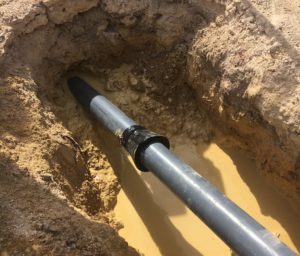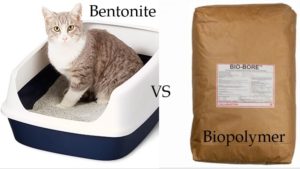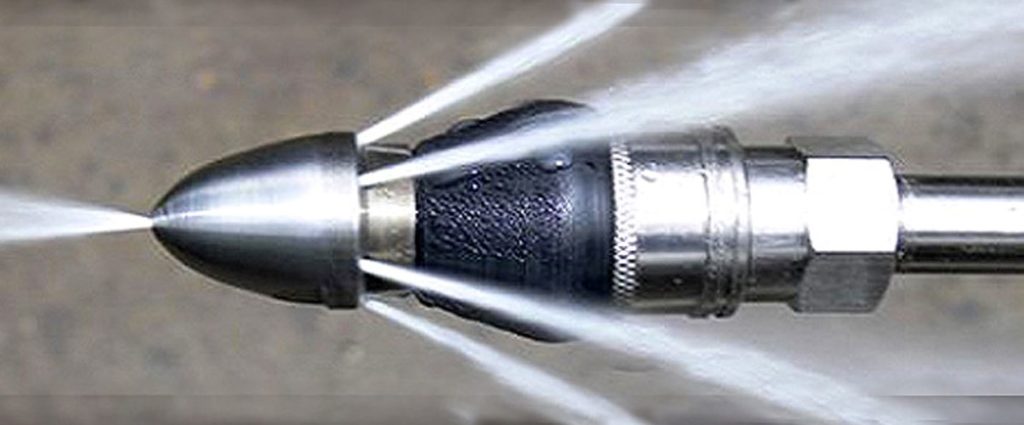How to “Develop” an SVE Well

Volume 8, Issue #3 – March 2022
If you’ve ever installed a vertical soil vapor extraction (SVE) well, you enjoyed a robust list of different drilling methods to choose from. Depending on the geology and sampling requirements, you might have chosen direct push, hollow stem auger, sonic or air rotary.
You did not select mud rotary.
Horizontal Directional Drilling (HDD) doesn’t have quite as broad a spectrum of drilling methods available. In fact, it’s pretty much mud rotary or nothing1.
Yet we use HDD to install SVE wells all the time. So, what gives?

A horizontal SVE well installed via mud rotary
To answer that question, we first need to learn a little bit more about the drilling mud2.
It’s All About Mud Properties and Development
Most mud rotary drilling operations use bentonite-based drilling fluids.
Bentonite is an inorganic clay (primarily montmorillonite), and it enjoys many characteristics that make for a wonderful drilling fluid. However, when installing a well screen that communicates with the formation, all those clay particles need to be physically removed from the near-well environment during the development process.
Complete and thorough well development requires bi-directional flow of fluid (i.e. into and out of the well). This means you can’t fully develop an SVE well, because the screen is installed in the vadose zone (you can pump in water to flush, but there’s no groundwater on the outside to pull back out).
Now flushing water into an SVE well screen will remove a lot of the drilling fluid. However, the lack of bi-directional flow means you’ll never get all of it out.
Without complete removal through development, residual bentonite in the bore can plug up the formation and limit the flow of vapors into the well screen. At a minimum the well performance might be below optimal. In the worst-case scenario, the well might not work at all.
Since wells in the vadose zone can’t really be thoroughly developed, this limitation makes bentonite-based drilling fluids a poor choice for SVE well installation.
Alternatives to Bentonite
While bentonite is the most common viscosifier for making up drilling fluids, it is not the only choice available.
Biopolymer muds achieve the target properties of a well-engineered drilling fluid by using long-chain starches (such as xanthan or guar gum) rather than inorganic clay. These products were originally developed for use in brackish groundwater conditions since the salt ions interfere with bentonite’s functionality. Rather than plaster a cake of clay over the bore walls, think of biopolymer molecules as acting more like a temporary glue to stick the bore surface together, without penetrating too far into the formation.

Bentonite is not the only drilling fluid available
Many years ago, the early pioneers of horizontal remediation wells learned quickly that well development in any horizontal well (and especially SVEs) proved much more difficult than vertically oriented installations. They recognized that replacing bentonite with these alternative biopolymers could solve the development challenge of horizontal well applications.
Comprising organic carbohydrates rather than inorganic clay, if some residual biopolymer remains in the bore following preliminary flushing efforts, any mud missed during development will eventually break down into carbon dioxide and water.
Unlike with bentonite-based muds, the original porosity and transmissivity of the formation can be restored even though an incomplete development process may leave some residual biopolymer behind.
Some Development is Still Needed
It’s important to note that switching to a biopolymer doesn’t mean the driller can just skip well development entirely.
For one thing leaving too much residual mud behind will likely mean the biopolymer will take too long to break down completely. Secondly, very high residual concentrations could lead to biofouling issues.
So, some development effort is required to flush out as much of the drilling fluid as possible before relying on the decomposition mechanism to finish the job.

High velocity jetting is an important part of horizontal well development
As in any development effort, a combination of mechanical and chemical energy is key to achieving thorough results. High velocity jetting helps loosen material in the near well environment and dislodge any sediment that may have packed off the screen slots during installation. Adding an enzyme to the make-up water accelerates the breakdown time.
Wet Soil Makes for a Crummy Vacuum
The “development” process for horizontal SVE wells requires one last crucial step. In order to get a good vacuum and pull a healthy air volume, an SVE well needs to be screened in dry soil. Any kind of moisture (not just drilling mud) will reduce the productivity of a vapor extraction system.
Removing the flushing/jetting water by running a stinger pipe connected to a vacuum or diaphragm pump through the full length of the well screen is an important step in the final development and completion of a horizontal SVE well.
You want to remove as much moisture as possible before turning on the vapor extraction system. Despite all these efforts, prudence dictates a knock-out plumbed in line to catch any residual moisture that may remain during start up.
Depending on soil conditions, it may take a while for the soil to dry out. We recently saw an SVE well that initially (within a week or two of installation) performed quite poorly. Fortunately, after a few months it began hitting on all cylinders.
When situations like that arise, we’re glad we used a biopolymer instead of bentonite. It’s one thing to wait for a little bit of moisture to dry out, but a pore space plugged off with clay bentonite might never start producing.
Conclusion
HDD is a mud rotary method. There’s no getting around that. However, the development challenges that limitation presents do not preclude the installation of horizontal SVE wells.
And that’s a good thing too. The flexibility and versatility of the HDD approach opens up so many options for SVE well configurations. It’d be a shame to let a little mud get in the way.
Footnotes:
1. Okay there are steerable air hammers…they’re complicated to operate and challenging to steer. That might be a topic we cover in a future article. For now, let’s just say that HDD requires mud rotary.
2. An old colleague used to complain about what a travesty it is to even call it “mud” at all. Mud has such negative connotations. He insisted on calling it an “Engineered Drilling Fluid”.
Tags: biopolymers, environmental HDD, HDD, horizontal SVE, horizontal wells, mud rotary, well development